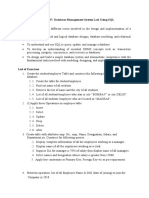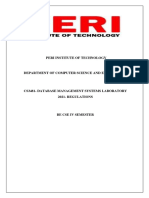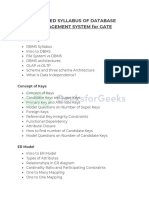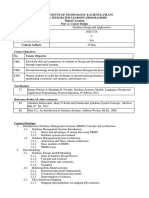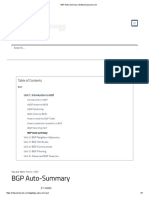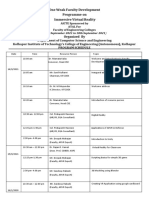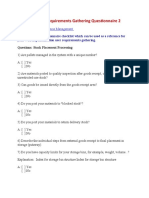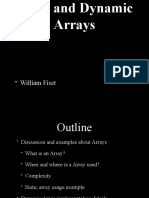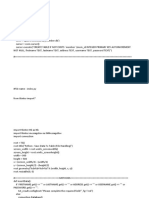(Chapter1),
Introduction to the course and its motivation. Course
Silberschatz,
description, objective, credit, grading pattern, class and All Cos,
Korth & Sud
L-01 Lab session of the course. NBA provided program POs,
harsan, (Chap
outcomes and departmental specific program specific PSOs
ter1), Alan
outcomes.
Beaulieu
L-02 Introduction to DBMS:- Data, Database, Database (Chapter1), CO 1
system, Application, Disadvantages of conventional Silberschatz,
FileSystem, Advantages of Database approach on File Korth & Sud
system harsan
L-03 Three level Data abstraction, Schema, Instances, Data (Chapter1), CO 1
Independence Silberschatz,
Korth & Sud
harsan
P-01 Assignment 1: Practicing DDL and DML Commands (Chapter3), CO 2
Silberschatz,
used for table creation and insertion Korth & Sud
harsan, (Chap
ter2), Alan
Beaulieu
L-04 Database Languages: DDL, DML, Database users, (Chapter1), CO 1
Silberschatz,
DBA, Korth & Sud
harsan
L-05 (Chapter1), CO 1
Data Models: ER model, Relational Model, Network
Silberschatz,
model, hierarchical model, Object based data model, Korth & Sud
semi structured data model, Relational databases, harsan
Database Design
L-06 (Chapter1), CO 1
Overall DB system architecture, Data Storage and Silberschatz,
querying Two tier and three tier architecture Korth & Sud
harsan
P-02 (Chapter3), CO 2
Assignment 2: Practicing DDL and DML commands for Silberschatz,
writing queries Korth & Sud
harsan, (Chap
� ter3), Alan
Beaulieu
L-07 ER Model:- Entity, attribute, Entity set, Relationship,(Chapter 7), CO 3
Silberschatz,
Relationship set, degree of relationship set, types of Korth & Sud
attributes with examples harsan
L-08 (Chapter CO 3
Mapping cardinalities Participation constraint, 2,7),
Database Keys: - Super key, Candidate key, Primary key, Silberschatz,
Alternate Key, Secondary key Korth & Sud
harsan
L-09 (Chapter 7), CO 3
Foreign key, Referential integrity, Key attributes of
Silberschatz,
relationship set, Strong, Weak entity, Identifying
Korth & Sud
relationship
harsan
P-03 (Chapter3), CO 2
Silberschatz,
Korth & Sud
Assignment 2 contd.
harsan, (Chap
ter4), Alan
Beaulieu
L-10 (Chapter7), CO 3
EER Features:- Specialization, Generalization, ISA
Silberschatz,
relationship , Constraints on Specialization,
Korth & Sud
Generalization, Aggregation
harsan
L-11 (Chapter7), CO 3
Designing an ER diagram using EER and ER featuresas Silberschatz,
a case study Korth & Sud
harsan
L-12 Relational database:- What is a Relation, Different Chapter 2,7), CO 4
features of a Relation( Attribute, Domain, Null value, Silberschatz,
Tuple ), Relational Schema , Relational Database Korth & Sud
Constraints harsan
P-04 (Chapter3), CO 2
Assignment 3: Practicing SQL queries using SQL Silberschatz,
operators, Aggregate and Scalar functions Korth & Sud
harsan, (Chap
� ter6), Alan
Beaulieu
L-13 (Chapter7), CO 4
Mapping ER model to Relational Model with examples Silberschatz,
and case study Korth & Sud
harsan
L-14 Relational Database Design:- Anomalies in (Chapter8), CO 4
Database(Insertion, Deletion, Updation Anomalies with Silberschatz,
examples), Normalization concept, Decomposition Korth & Sud
Method, harsan
L-15 (Chapter8), CO 4
Functional Dependencies, Trivial functional dependency, Silberschatz,
Inference Rules for FDs, Closure of FD Korth & Sud
harsan
P-05 (Chapter3), CO 2
Silberschatz,
Korth & Sud
Assignment 3 contd.
harsan, (Chap
ter7), Alan
Beaulieu
L-16 (Chapter8), CO 4
Silberschatz,
Attribute closure, Extraneous attribute, Canonical Cover
Korth & Sud
harsan
L-17 (Chapter8), CO 4
Silberschatz,
Decomposition, Properties of Decomposition, Loss less Korth & Sud
decomposition, Dependency preserving decomposition, harsan
L-18 (Chapter8), CO 4
Silberschatz,
Normalization, INF, Second normal form
Korth & Sud
harsan
P-06 (Chapter3), CO 2
Assignment 3 contd. Silberschatz,
Korth & Sud
harsan, (Chap
� ter8), Alan
Beaulieu
L-19 (Chapter8), CO 4
Silberschatz,
3NF, BCNF, comparison of 3NF with BCNF
Korth & Sud
harsan
L-20 (Chapter8), CO 4
Multivalued dependency, inference rules to find closure Silberschatz,
of multivalued dependency set Korth & Sud
harsan
L-21 (Chapter8), CO 4
Silberschatz,
4NF,Problems based on normalization, Denormalization
Korth & Sud
harsan
P-07 (Chapter4), CO 2
Silberschatz,
Korth & Sud
Assignment 4: Table creation using Database Constraints
harsan, (Chap
ter13), Alan
Beaulieu
L-22 (Chapter6), CO 5
Relational Query Language:- Procedural and Non-
Silberschatz,
Procedural query language, Relational Algebra :-
Korth & Sud
Selection, Projection, union
harsan
L-23 (Chapter6), CO 5
Relational algebra queries based on Set difference, Silberschatz,
Cartesian product, Rename Korth & Sud
harsan
L-24 (Chapter6), CO 5
Relational algebra queries based on Set intersection,
Silberschatz,
Assignment, Natural Join, Extended relational algebra
Korth & Sud
operations
harsan
P-08 (Chapter4), CO 2
Silberschatz,
Korth & Sud
Assignment 4 contd.
harsan, (Chap
ter13), Alan
Beaulieu
�L-25 (Chapter6), CO 5
Queries using Tuple relational calculus, Natural Join in Silberschatz,
TRC Korth & Sud
harsan
L-26 (Chapter6), CO 5
Domain Relational Calculus, Natural Join in Domain Silberschatz,
relational calculus Korth & Sud
harsan
L-27 (Chapter14), CO 6
Transaction, ACID Properties of transaction, States of Silberschatz,
Transaction Korth & Sud
harsan
P-09 (Chapter4), CO 2
Silberschatz,
Assignment 5: Practicing DML commands using sub Korth & Sud
queries and Join harsan, (Chap
ter4,9), Alan
Beaulieu
L-28 (Chapter14), CO 6
Transaction Schedule, serial and concurrent schedule, Silberschatz,
Serializability Korth & Sud
harsan
L-29 (Chapter14), CO 6
Silberschatz,
Conflict Serializability, View serializability
Korth & Sud
harsan
L-30 (Chapter14), CO 6
Recoverability, Recoverable and Cascade less Schedule Silberschatz,
with example Korth & Sud
harsan
P-10 (Chapter4), CO 2
Silberschatz,
Korth & Sud
Assignment 5 contd.
harsan, (Chap
ter5,10), Alan
Beaulieu
�L-31 (Chapter15), CO 6
Concurrency control: Need, Lock based concurrency
Silberschatz,
control, 2 phase locking protocol, strict and rigorous
Korth & Sud
2phase locking protocol
harsan
L-32 (Chapter15), CO 6
Time-Stamp-based concurrency control, Multi version Silberschatz,
Scheme protocol, advantages and performance Korth & Sud
harsan
L-33 (Chapter16), CO 6
Recovery System:- DB storage and failure, Log-based Silberschatz,
Recovery, REDO and UNDO operations Korth & Sud
harsan
P-11 (Chapter5), CO 2
Silberschatz,
Assignment 6: Project Based on Database Connectivity
Korth & Sud
harsan
L-34 (Chapter16), CO 6
Recovery in Deferred Database Modification and Silberschatz,
Immediate Database Modification, Check Pointing Korth & Sud
harsan
L-35 (Chapter11), CO 6
Storage and access Strategies : ordered Indices, primary
Silberschatz,
and secondary index, dense and sparse index, multilevel
Korth & Sud
indexing
harsan
L-36 (Chapter11), CO 6
B+-tree index _le, Hashing, Hash function and hashed Silberschatz,
files, Hashed index Korth & Sud
harsan
P-12 (Chapter5), CO 2
Silberschatz,
Assignment 6 contd.
Korth & Sud
harsan,
L-37 (Chapter12), CO 6
Query Processing; Overview, Measures of query cost,
Silberschatz,
Selection operation, Sorting, join operation, Evaluation
Korth & Sud
of query cost.
harsan
�L-38 (Chapter13), CO 6
Query Optimization: Overview, Transformation of Silberschatz,
Relational expressions Korth & Sud
harsan
L-39 (Chapter13), CO 6
Estimating statistics of expression results, Choice of Silberschatz,
evaluation plan Korth & Sud
harsan
P-13 (Chapter5), CO 2
Silberschatz,
Assignment 6 contd.
Korth & Sud
harsan,
L-40 (Chapter17), CO 6
Silberschatz,
Database System Architectures
Korth & Sud
harsan
Program Outcomes (PO) and Program Specific Outcomes (PSO)
POs Description
PO1 Engineering knowledge: Apply the knowledge of mathematics, science, engineering
fundamentals, and an engineering specialization to the solution of complex engineering
problems.
PO2 Problem analysis: Identify, formulate, review research literature, and analyse complex
engineering problems reaching substantiated conclusions using first principles of mathematics,
natural sciences, and engineering sciences.
PO3 Design/development of solutions: Design solutions for complex engineering problems and
design system components or processes that meet the specified needs with appropriate
consideration for the public health and safety, and the cultural, societal, and environmental
considerations.
PO4 Conduct investigations of complex problems: Use research-based knowledge and research
methods including design of experiments, analysis and interpretation of data, and synthesis of
the information to provide valid conclusions.
PO5 Modern tool usage: Create, select, and apply appropriate techniques, resources, and modern
engineering and IT tools including prediction and modelling to complex engineering activities
with an understanding of the limitations.
�PO6 The engineer and society: Apply reasoning informed by the contextual knowledge to assess
societal, health, safety, legal and cultural issues, and the consequent responsibilities relevant to
the professional engineering practice.
PO7 Environment and sustainability: Understand the impact of the professional engineering
solutions in societal and environmental contexts, and demonstrate the knowledge of, and need
for sustainable development.
PO8 Ethics: Apply ethical principles and commit to professional ethics and responsibilities and
norms of the engineering practice.
PO9 Individual and teamwork: Function effectively as an individual, and as a member or leader in
diverse teams, and in multidisciplinary settings.
PO10 Communication: Communicate effectively on complex engineering activities with the
engineering community and with society at large, such as, being able to comprehend and write
effective reports and design documentation, make effective presentations, and give and receive
clear instructions.
PO11 Project management and finance: Demonstrate knowledge and understanding of the
engineering and management principles and apply these to one’s own work, as a member and
leader in a team, to manage projects and in multidisciplinary environments.
PO12 Life-long learning: Recognize the need for and have the preparation and ability to engage in
independent and life-long learning in the broadest context of technological change.
PSO1 The ability to understand, analyze and develop computer programs in the areas related to
business intelligence, web design and networking for efficient design of computer-based
systems of varying complexities.
PSO2 The ability to apply standard practices and strategies in software development using open-ended
programming environments to deliver a quality product for business success.


















